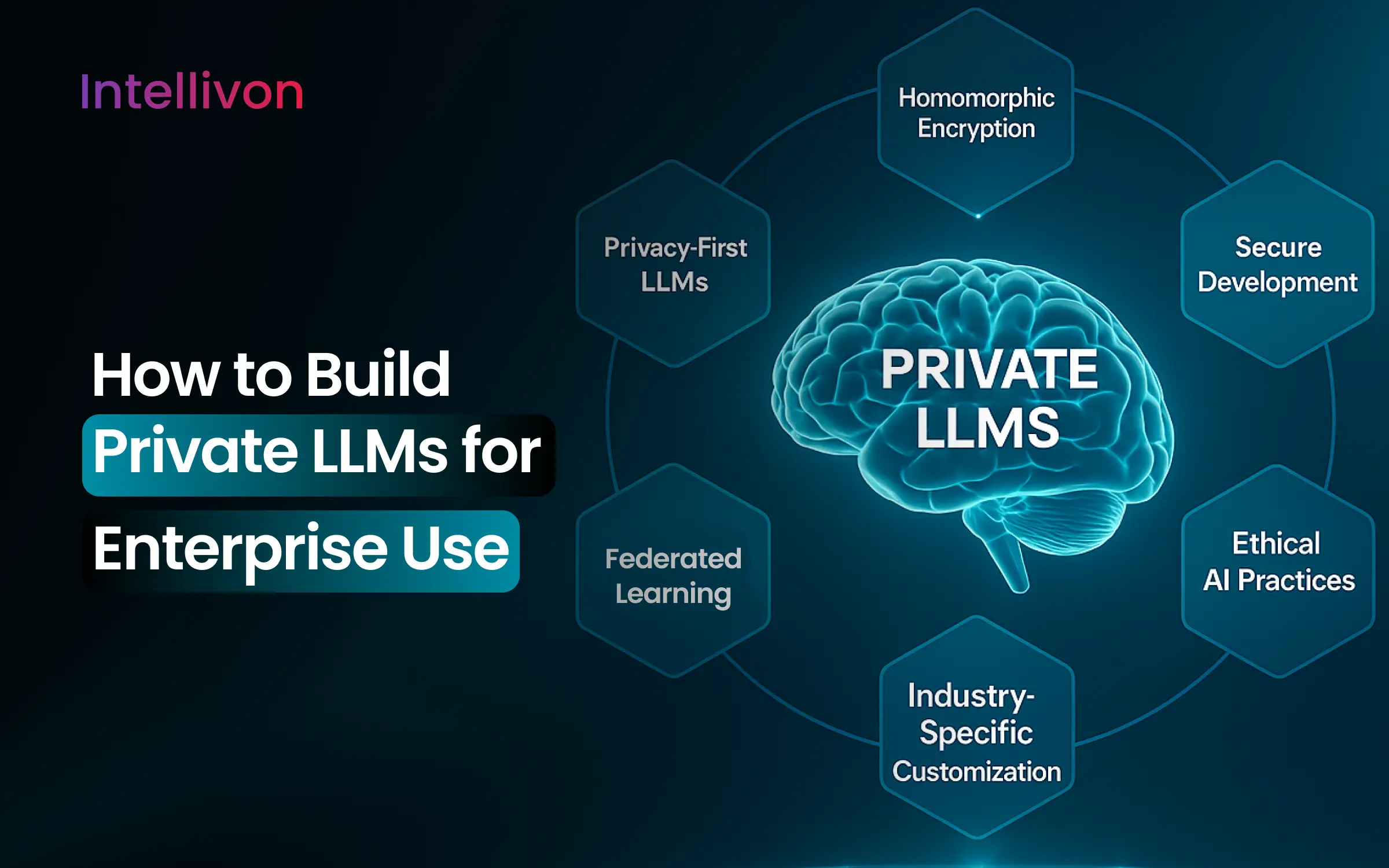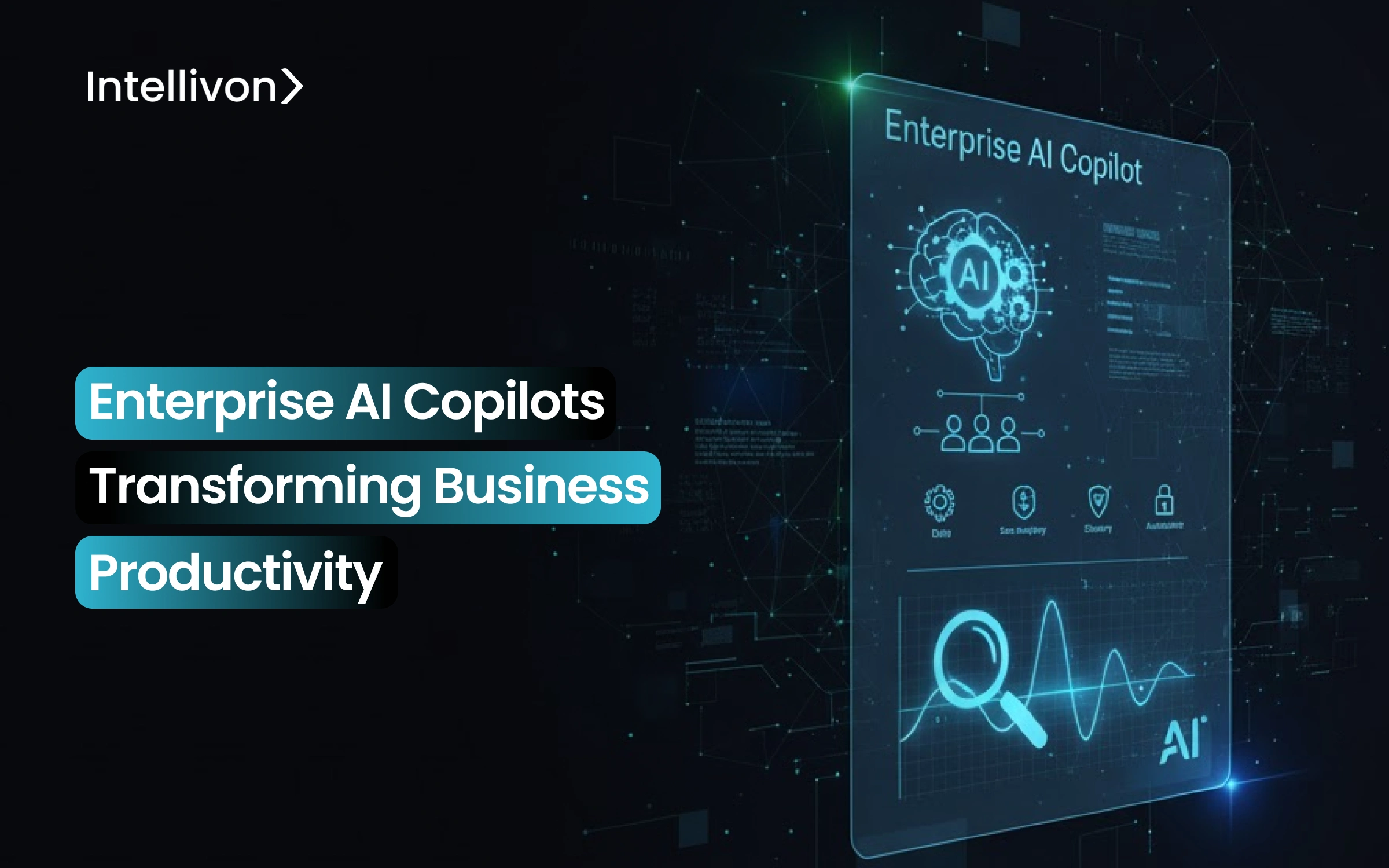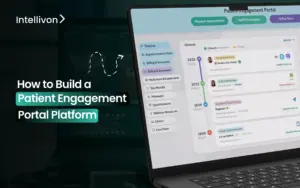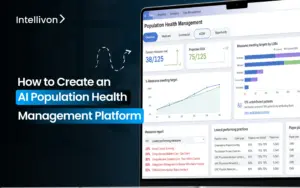Productivity in most enterprises fails because critical workflows are trapped under repetitive manual tasks. Leaders watch their best people spend hours generating compliance reports, reconciling data across platforms, and chasing approvals through email threads, all while strategic work sits untouched. Enterprise AI copilots represent a fundamental shift in how work gets done, not by replacing expertise, but by eliminating the repetitive tasks that bury it. These are intelligent systems that understand business context, orchestrate multi-step processes, and execute with the precision your operations demand.
Intellivon specializes in building enterprise AI copilots that are secure, compliant, and engineered for measurable impact. Over the years, we have witnessed firsthand how properly architected copilots that are built with governance and scalability from the ground up transform productivity at scale. In this blog, we’ll explore what enterprise AI copilots truly are, how they work, where they create the most value, and the practices that make them scalable across the enterprise.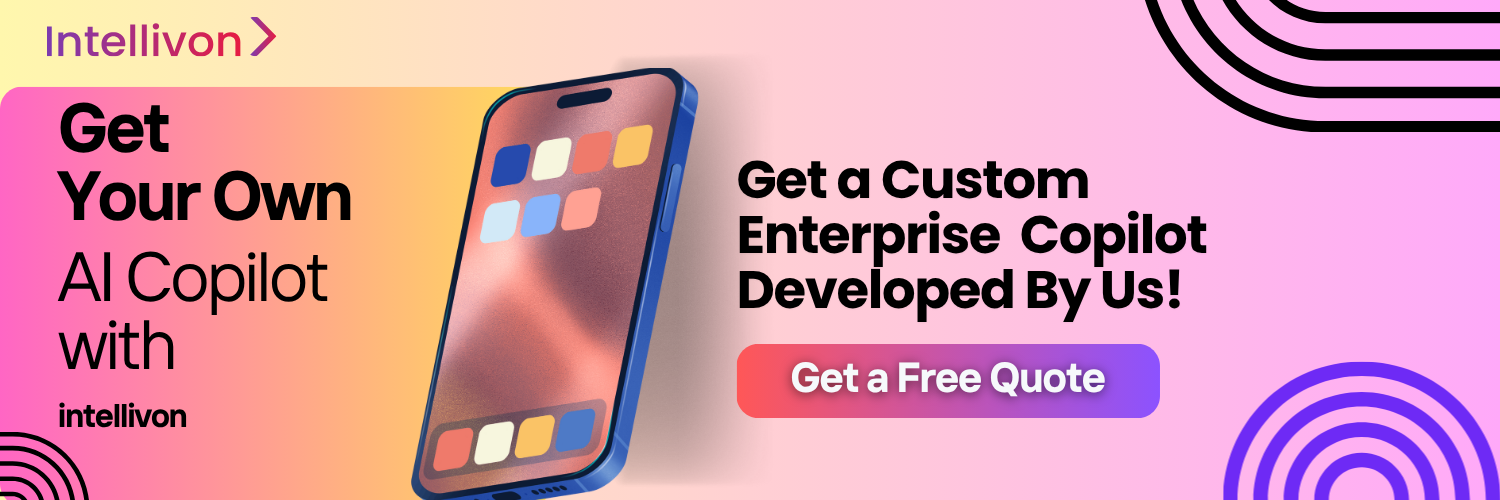
What Are Enterprise AI Copilots?
Enterprise AI copilots are intelligent systems designed to operate alongside employees, not replace them. Unlike traditional chatbots that answer queries or virtual assistants that handle isolated tasks, copilots combine multiple AI capabilities to function as digital colleagues. They can interpret a request in plain language, break it into actionable steps, retrieve information from enterprise systems, and execute tasks while ensuring compliance and auditability.
The distinction lies in outcomes. An AI copilot goes above and beyond summarizing a policy document and prepares an audit-ready report. Similarly, it reconciles pricing, highlights risks, and drafts the purchase order, but doesn’t simply provide supplier data. This shift from conversation to execution makes copilots fundamentally different from earlier automation tools. By embedding them directly into enterprise workflows, organizations create a layer of intelligence that works across finance, operations, customer service, and compliance. This turns time-consuming, error-prone processes into streamlined, governed actions that scale.
Business Value: Why Enterprises Need Copilots Now
The enterprise AI market size reached approximately $14.4 billion in 2025 and is projected to grow to $126 billion by 2035, with a CAGR above 25%. Within this broader growth, AI copilots are emerging as one of the fastest-scaling segments, attracting significant enterprise investment and accelerating adoption timelines.
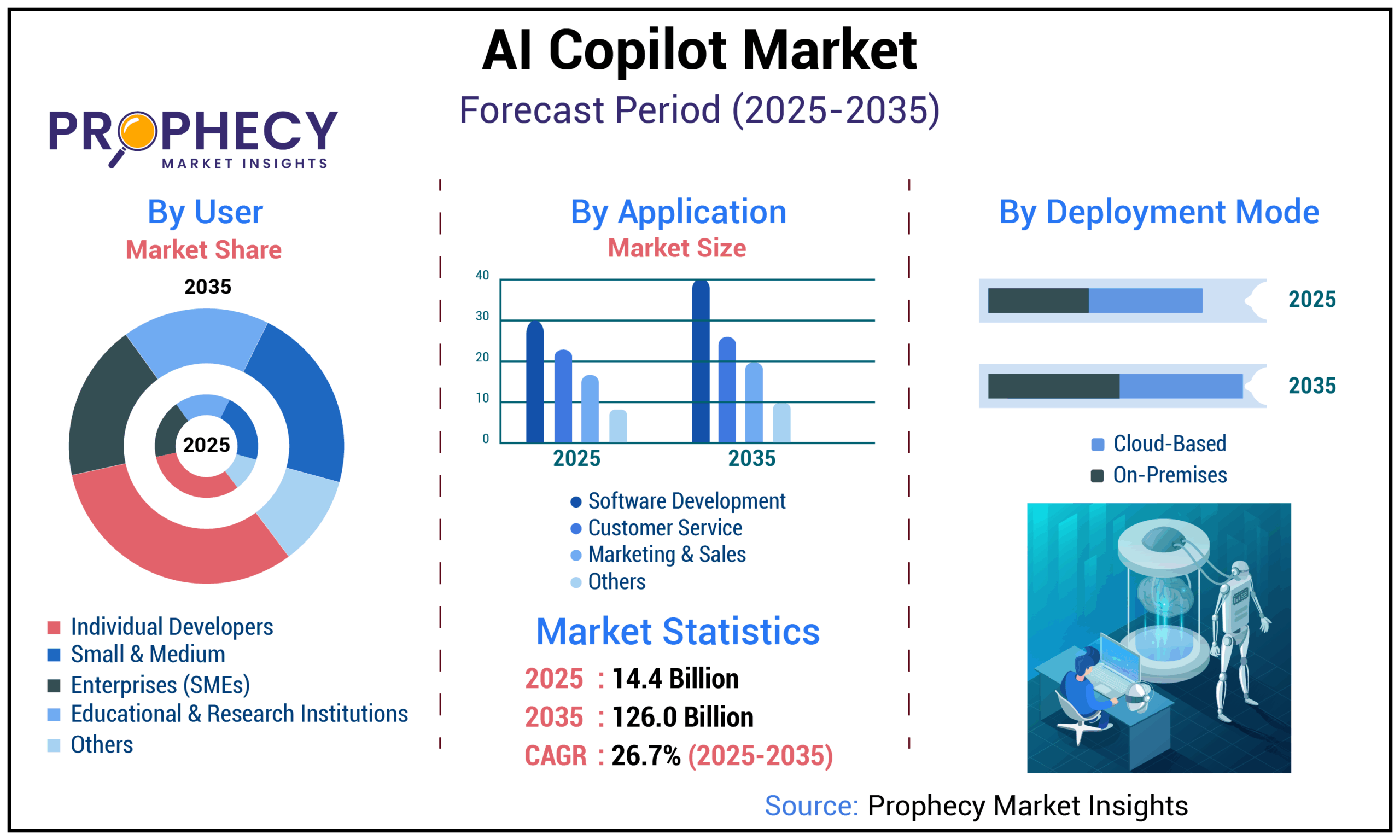
Adoption Momentum
- The AI copilot sub-market is projected to hit over $13 billion in annual revenue by the end of 2025, showing 150%+ year-over-year growth fueled by adoption in recruiting, sales, customer service, and workflow automation.
- 62% of organizations increased their generative AI spending in 2025.
- 36% of enterprises have deployed generative AI at scale or limited scale, reflecting rapid adoption momentum across industries.
Measurable ROI and Productivity Gains
- AI investments yield an average ROI of 1.7x across business operations.
- Enterprises see 26–31% reductions in operating costs and 40–45% efficiency gains in customer service, finance, and supply chain functions.
- Agentic AI projects (including copilots) are expected to grow 48% in 2025, with 62% of surveyed enterprises projecting ROI above 100%.
- Mature markets like the U.S. report average ROI between 171% and 192%.
- Companies with strong AI readiness achieve ROI milestones 45% faster than competitors, making copilots a competitive accelerant.
Strategic and Operational Benefits
- Copilots reduce decision latency and break down silos by connecting workflows across departments.
- They provide real-time, contextual assistance, enabling better resource allocation and more agile planning.
- Automating repetitive tasks frees employees for high-value work, with productivity boosts reported up to 40%.
Risk Mitigation and Compliance
- Copilots with built-in compliance and audit features reduce regulatory risk by enforcing consistent policy adherence across workflows.
- 77% of executives prefer proprietary AI models for better control of data privacy and security. Copilots that are designed with these guardrails safeguard sensitive enterprise information.
How Enterprise AI Copilots Work in Organizations
Enterprise AI copilots work by turning intent into action. When a user makes a request, such as “prepare a compliance audit summary,” or “generate a client portfolio review,” the copilot doesn’t stop at understanding the question. It decomposes the request into smaller steps, retrieves the right data, applies the necessary rules or models, and executes tasks securely within enterprise systems.
This orchestration is what sets copilots apart. They combine conversational fluency with structured reasoning, access to enterprise data, and integration across applications. The result is not just information, but outcomes: reports delivered, claims processed, purchase orders raised, or contracts reviewed. In practice, they function less like an assistant and more like a governed layer of intelligence embedded directly into workflows.
How Enterprise AI Copilots Differ from Chatbots and LLMs
| Feature | Chatbots | LLM-Powered Assistants | Enterprise AI Copilots |
| Core Role | Answer FAQs with scripted flows | Generate insights and summaries | Execute outcomes across workflows |
| Data Access | Static knowledge bases | Connect to documents and unstructured data | Integrate with enterprise systems and governed data fabric |
| Context Handling | Limited, session-based | Conversational continuity | Task memory and enterprise context across steps |
| Governance | Basic escalation rules | Few guardrails | Full auditability, compliance, and access controls |
| Value Delivered | Reduces call volumes | Improves productivity | Transforms workflows and enables measurable ROI |
Through this comparison table, it is clear that chatbots answer, LLMs assist, but enterprise AI copilots act. They deliver outcomes while staying compliant with enterprise rules, which makes them fundamentally more valuable in large-scale operations.
Types of Enterprise AI Copilots
Enterprise AI copilots come in different forms depending on their design, purpose, and depth of integration. Understanding these variations helps leaders identify what stage their organization may be ready for and what level of value to expect. Broadly, we see four types emerging across industries.
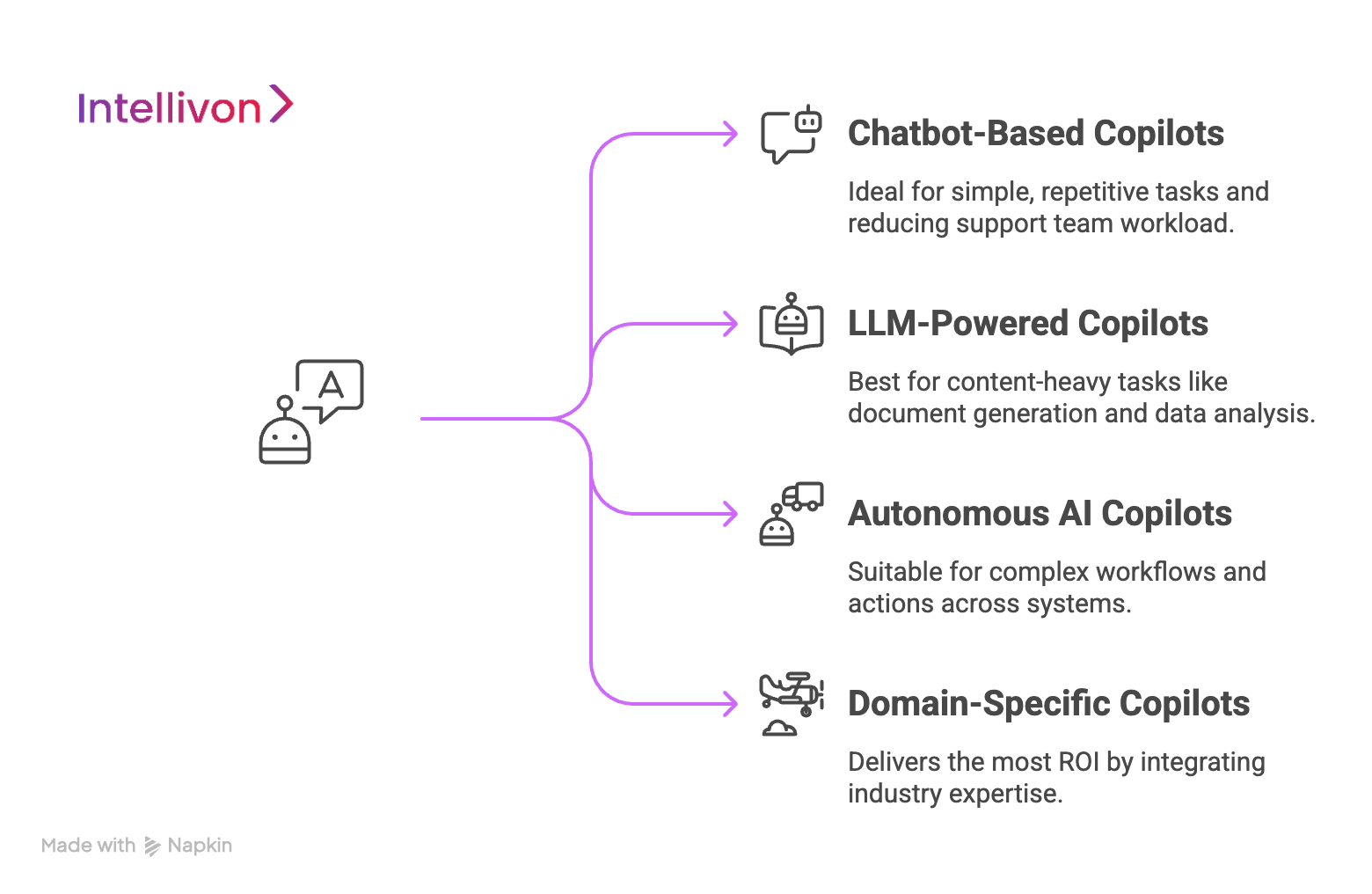
1. Chatbot-Based Copilots
These represent the most basic category. They extend traditional chatbots by offering conversational support for simple, repetitive tasks such as HR inquiries, IT helpdesk requests, or frontline customer service. They ease pressure on support teams but remain limited in reasoning and workflow execution.
Examples: ServiceNow Virtual Agent, Zendesk’s Answer Bot, Microsoft Teams bots.
2. LLM-Powered Copilots
LLM copilots take a significant step forward. Built on large language models, they can generate summaries, draft documents, and analyze unstructured data. They are already widely used in functions that demand content-heavy work like legal research, reporting, or coding. However, without orchestration, they still act as assistants rather than true outcome drivers.
Examples: GitHub Copilot, Google Duet AI, Microsoft 365 Copilot.
3. Autonomous Enterprise AI Copilots
This category goes beyond conversation and insight. These copilots can interpret intent, plan multi-step workflows, and take actions across enterprise systems. They are valuable in areas like financial reconciliations, compliance reporting, and supply chain orchestration, where accuracy and execution matter as much as analysis.
Examples: Adept ACT-1, copilots built on LangChain or AutoGen frameworks.
4. Domain-Specific Copilots
Domain copilots embed industry expertise directly into their design. They integrate regulatory frameworks, specialized workflows, and sector-specific AI models. Because they are tailored to industries like law, finance, or healthcare, they tend to deliver the most measurable ROI.
Examples: Thomson Reuters CoCounsel for law, BloombergGPT copilots in finance, Epic’s AI assistants in healthcare.
In summary, copilots evolve along a maturity curve, where chatbots reduce workload, LLM copilots accelerate productivity, autonomous copilots deliver execution at scale, and domain copilots transform industry-critical workflows. For enterprises evaluating options, understanding this spectrum is crucial to choosing the right starting point and the right trajectory for growth.
Architecture of Enterprise AI Copilots
Enterprise AI copilots are not single tools running in isolation. They are layered systems, carefully engineered to handle intent, orchestrate tasks, and execute securely across complex enterprise environments. Each layer plays a distinct role in ensuring that copilots don’t just deliver answers but provide outcomes enterprises can trust.
1. Interaction Layer
This is where users engage with the copilot through chat, voice, or embedded applications such as Teams, Slack, or ERP dashboards. It sets the tone for adoption by fitting seamlessly into existing workflows.
2. Orchestration Layer
The orchestration layer is the planning brain of the copilot. It breaks down goals into smaller steps, decides which skills or tools to use, and coordinates multi-step actions. Without orchestration, copilots remain assistants rather than collaborators.
3. Skills and Tools Layer
Here, business actions are defined as reusable skills, such as “generate a compliance report” or “initiate purchase order.” Each skill has clear inputs, outputs, and permissions, making copilots reliable in production environments.
4. Intelligence Layer
This layer blends large language models, machine learning, retrieval pipelines, and business rules. It ensures copilots choose the most accurate and cost-effective approach instead of relying on a single model for everything.
5. Enterprise Data Fabric
Copilots draw on a governed data foundation, connecting to ERP, CRM, EHR, supply chain platforms, and proprietary knowledge bases. By grounding actions in source-of-truth systems, they maintain both accuracy and compliance.
6. Governance and Compliance Layer
Access controls, audit logs, encryption, and policy enforcement are embedded here. Every action is explainable and regulator-ready, turning compliance from a barrier into an enabler of scale.
7. Observability and Monitoring
Dashboards track accuracy, latency, cost per task, and adoption metrics. With these in place, copilots are managed like enterprise infrastructure rather than experimental pilots.
At Intellivon, we design architectures where each layer reinforces compliance, scalability, and cost efficiency, turning copilots into a reliable enterprise infrastructure that supports growth, not just productivity.
How Enterprise AI Copilot Transforms Business Productivity Across Industries
Enterprise AI copilots adapt to the unique pressures of each industry, transforming bottlenecks into opportunities for scale. The following sections highlight how different sectors are already realizing value, with specific use cases and real-world examples.
1. Financial Services
Financial institutions operate in a landscape defined by risk, regulation, and high customer expectations. Copilots in this sector bring speed and precision to processes that are otherwise slow, manual, and compliance-heavy.
A. Risk and Compliance Monitoring
Copilots analyze transactions, monitor regulatory updates, and flag anomalies in near real time. This reduces exposure to fines and strengthens governance across the institution.
B. Client Portfolio Management
They can surface insights from market data, generate portfolio summaries, and suggest allocation adjustments based on risk profiles, freeing advisors to focus on strategic conversations.
C. Fraud Detection and Investigation
Copilots augment fraud teams by cross-checking suspicious activities against historical data, customer behavior patterns, and external signals, enabling faster detection and reduced false positives.
Example: Morgan Stanley
Morgan Stanley deployed an AI copilot to help wealth advisors retrieve and summarize firm research. Adoption rates surpassed 98%, accuracy in retrieving the right content improved nearly fourfold, and advisors saved hours previously spent searching, enabling more client-facing engagement.
2. Healthcare
Administrative burdens, clinical documentation, and compliance demands strain healthcare systems. Copilots ease these pressures by augmenting clinicians and administrators, giving them more time to focus on patient care.
A. Clinical Documentation
Copilots capture physician-patient conversations, generate structured notes, and insert them into EHRs. This reduces after-hours “pajama time” and lowers burnout among clinicians.
B. Patient Engagement
They support patient-facing tasks such as scheduling, pre-visit checklists, and follow-up reminders, improving both operational efficiency and patient satisfaction.
C. Compliance and Reporting
Healthcare copilots assist with generating HIPAA-compliant documentation, audit packs, and coding summaries that reduce administrative workload and human error.
Example: Providence Health
Providence adopted Nuance DAX Copilot to automate note-taking during clinical visits. Physicians reported saving over two hours per week on documentation, with burnout scores dropping significantly and patient satisfaction improving due to more face-to-face time.
3. Legal Services
Law firms and in-house legal teams deal with overwhelming volumes of contracts, case law, and regulatory documents. Copilots reduce the manual intensity of this work and help lawyers focus on strategic judgment.
A. Contract Review and Drafting
Copilots analyze contracts, flag unusual clauses, and even generate draft agreements based on playbooks, saving lawyers from repetitive review tasks.
B. Legal Research
They surface relevant precedents and case law with citations, cutting research time from hours to minutes while improving accuracy.
C. Litigation Preparation
Copilots can organize discovery materials, summarize depositions, and generate trial briefs that give lawyers more time to focus on case strategy.
Example: Allen & Overy
The global law firm partnered with Harvey (an AI legal copilot) to enhance legal research and drafting. Associates report faster first drafts and improved clause consistency across client work, freeing senior lawyers to focus on higher-value tasks.
4. Insurance
The insurance sector thrives on efficiency in claims, underwriting, and risk assessment. Copilots accelerate these workflows and improve customer experience at the same time.
A. Claims Processing
Copilots extract details from claims submissions, validate documents, and draft settlement recommendations, reducing turnaround time significantly.
B. Risk Assessment and Underwriting
They analyze applicant data, medical history, and actuarial models to support underwriters in faster, more accurate policy decisions.
C. Customer Support
Insurance copilots manage queries, explain coverage details, and guide customers through policy adjustments, improving responsiveness.
Example: Zurich Insurance
Zurich has piloted AI copilots in claims management, reporting faster resolution times and improved accuracy in fraud detection, leading to both cost savings and higher customer satisfaction.
5. Retail and Consumer Goods
Retailers manage vast product catalogs, supply chains, and high volumes of customer interactions. Copilots enhance decision-making while improving both customer and employee experiences.
A. Inventory Management
Copilots forecast demand, flag low stock, and suggest replenishment strategies by analyzing sales patterns and supplier data.
B. Customer Experience
They support omnichannel service by answering product questions, managing returns, and personalizing offers at scale.
C. Marketing Optimization
Retail copilots generate campaign briefs, analyze performance, and recommend adjustments to increase ROI from digital channels.
Example: Walmart
Walmart has adopted copilots for store associates, enabling them to instantly check stock, update pricing, and answer customer questions. This reduced service friction and gave staff more time for value-added interactions.
6. Supply Chain and Manufacturing
Manufacturers and logistics leaders depend on precise coordination across suppliers, production lines, and distribution networks. Copilots improve visibility and speed of response across these complex systems.
A. Supplier Risk Management
Copilots scan financial, geopolitical, and operational signals to identify at-risk suppliers before disruptions occur.
B. Production Planning
They analyze order pipelines, resource availability, and maintenance schedules to recommend optimized production runs.
C. Logistics Optimization
Copilots track shipments, anticipate delays, and recommend rerouting strategies to minimize disruptions and costs.
Example: Unilever
Unilever has tested AI copilots to improve supply chain planning, reporting a reduction in forecasting errors and faster decision cycles in inventory management.
7. Energy and Utilities
This industry is undergoing digital transformation, where copilots help balance infrastructure demands, sustainability goals, and operational safety.
A. Grid Monitoring
Copilots process IoT sensor data to detect anomalies in real time, preventing outages and improving reliability.
B. Predictive Maintenance
They forecast when critical equipment is likely to fail, scheduling maintenance proactively to reduce downtime.
C. Sustainability and ESG Reporting
Energy copilots generate audit-ready ESG reports by consolidating data across assets, regions, and suppliers.
Example: Shell
Shell has been investing in AI copilots to optimize drilling operations and monitor energy efficiency, helping reduce costs and accelerate progress toward sustainability goals.
Step-by-Step Process: How Intellivon Builds Enterprise AI Copilots
Many organizations get stuck at the proof-of-concept stage because their copilots lack governance, integration, or measurable impact. Intellivon’s nine-step approach addresses these gaps directly, ensuring copilots are not just impressive in demos but transformative in real-world enterprise environments.
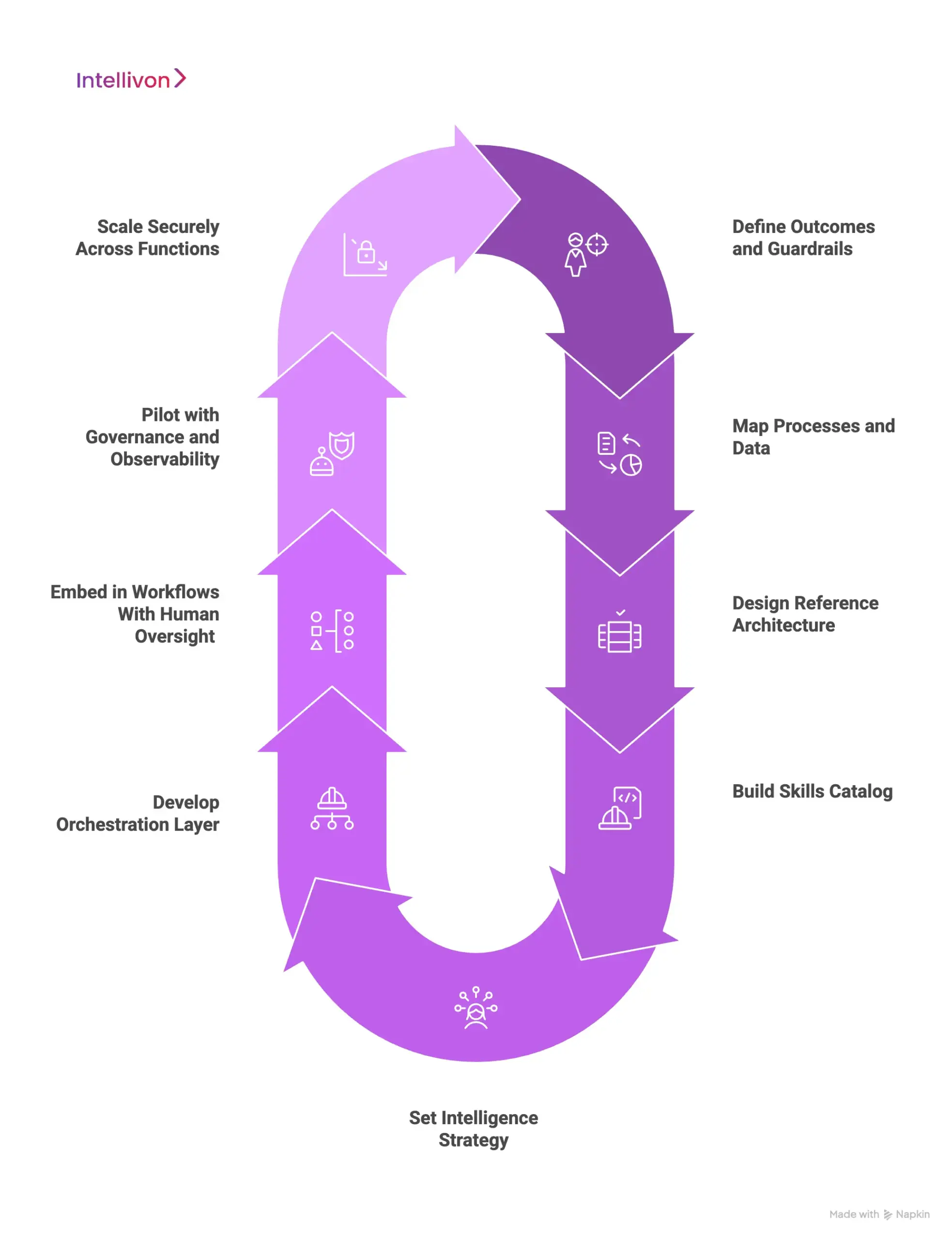
1. Define Outcomes and Guardrails
Every successful build begins with precision. We work with stakeholders to define the top two or three workflows where copilots can deliver the highest ROI. At the same time, we set boundaries on what the system can and cannot do, particularly in compliance-heavy areas.
This upfront clarity prevents scope creep and ensures leadership alignment before a single line of code is written.
2. Map Processes and Data
Enterprises run on a complex web of processes and data sources, many of which are fragmented or poorly documented. We baseline existing workflows, identify systems of record, and classify sensitive data that requires stricter handling.
By mapping these elements in detail, we give copilots a strong foundation to act reliably, with clear lineage back to the source of truth.
3. Design the Reference Architecture
We design copilots as layered systems, not monoliths. This architecture includes the interaction layer, orchestration engine, skills catalog, intelligence stack, enterprise data fabric, governance controls, and monitoring dashboards.
Each component plays a role in scalability and security. With this approach, enterprises can evolve or replace individual layers over time without breaking the entire system.
4. Build the Skills Catalog
Instead of coding ad hoc automations, we structure business actions as modular skills. A skill like “generate compliance report” has defined inputs, outputs, permissions, and validation rules. This catalog grows over time, becoming the backbone of the copilot’s capabilities.
By designing skills as reusable and schema-driven, copilots remain consistent, predictable, and adaptable across departments.
5. Set the Intelligence Strategy
Enterprises cannot afford to funnel every request through one large model. We design a routing strategy where lightweight LLMs handle simple language tasks, domain-specific ML models process predictions, retrieval pipelines ground responses in enterprise data, and rule engines enforce compliance.
This hybrid approach balances accuracy, cost, and performance while keeping control firmly in enterprise hands.
6. Develop the Orchestration Layer
At the heart of the copilot is orchestration, which is the copilot’s ability to break down intent into actionable steps and execute them in sequence. The orchestration layer decides which skills to invoke, validates outputs, and manages retries or error handling.
Without this, copilots remain passive assistants. With it, they become proactive colleagues capable of delivering completed outcomes end-to-end.
7. Embed in Workflows with Human Oversight
Adoption hinges on familiarity. We integrate the Copilot into the tools employees already use, whether that’s Teams, Slack, or ERP dashboards.
Human-in-the-loop checkpoints ensure critical actions pass through review, giving managers confidence in the system’s reliability. This combination of seamless access and controlled oversight accelerates adoption across even the most skeptical teams.
8. Pilot with Governance and Observability
Before scaling widely, we deploy copilots in controlled pilot environments that replicate production conditions. Dashboards track metrics like accuracy, latency, cost per transaction, and adoption rates.
This stage generates both ROI evidence for executives and compliance evidence for regulators. Pilots are not just test runs; they are proof points that copilots can operate under enterprise scrutiny.
9. Scale Securely Across Functions
Once proven, copilots are scaled into new workflows, business units, and geographies. Guardrails are tightened, monitoring is expanded, and skills are added to the catalog.
The copilot becomes a living platform, continuously refined based on feedback and usage. By this stage, enterprises see copilots evolve from a point solution into a critical layer of their operational fabric.
Intellivon’s approach ensures copilots are designed as governed, outcome-driven platforms that executives can trust. They embed intelligence into the enterprise in a way that is scalable, secure, and measurable.
Cost of Developing Enterprise AI Copilots
At Intellivon, we understand that enterprises need AI copilots that are both powerful and cost-effective. That’s why our pricing approach is flexible and aligned with your requirements, not a one-size-fits-all package.
If projected costs risk exceeding your planned budget, we work closely with your teams to refine scope while safeguarding core value in productivity, compliance, and operational efficiency.
Estimated Phase-Wise Cost Breakdown
| Phase | Description | Estimated Cost Range (USD) |
| Discovery & Strategy Alignment | Requirement gathering, workflow analysis, KPI mapping, compliance readiness (GDPR, HIPAA, SOC 2) | $6,000 – $12,000 |
| Architecture & Design | Copilot blueprint, layered architecture planning (interaction, orchestration, data, governance), integration mapping | $8,000 – $15,000 |
| Core Skill Development | Building modular, reusable enterprise actions (e.g., compliance reports, order processing) with schema and guardrails | $12,000 – $25,000 |
| Intelligence & Model Integration | LLM/ML selection, retrieval pipelines, model routing for accuracy and cost efficiency | $10,000 – $20,000 |
| Workflow Orchestration Engine | Orchestration logic, multi-step planning, task execution, validation, and audit logging | $10,000 – $22,000 |
| Platform Development & Customization | Dashboards, ERP/CRM connectors, role-based workflows, user-facing interfaces (Teams, Slack, ERP apps) | $12,000 – $25,000 |
| Security & Compliance Alignment | Encryption, access control, regulatory alignment (GDPR, HIPAA, SOX), monitoring and audit frameworks | $8,000 – $15,000 |
| Testing & Validation | Scenario simulations, compliance audits, workflow stress-testing, performance tuning | $6,000 – $10,000 |
| Deployment & Scaling | Cloud rollout, data residency setup, enterprise-wide embedding, monitoring dashboards | $6,000 – $12,000 |
- Total Initial Investment Range: $50,000 – $150,000
- Ongoing Maintenance & Optimization (Annual): 15–20% of initial build cost
Hidden Costs of Enterprise AI Copilot Development
Beyond core development, enterprises often face additional costs that are less visible upfront but impact scalability.
- Integration Complexity: Connecting to legacy ERP, CRM, or EHR systems often requires custom middleware and additional testing.
- Data Preparation and Cleanup: Training copilots on enterprise-grade data demands normalization, labeling, and de-duplication.
- Compliance Overhead: Jurisdiction-specific regulations (GDPR, HIPAA, SOX) add layers of governance that must be enforced from the start.
- Model Usage Costs: LLM APIs or custom training cycles can create recurring spend if not optimized.
- Change Management: Driving adoption requires structured training, onboarding, and communication initiatives across departments.
- Maintenance and Monitoring: Ongoing observability, patching, and skill updates are required to keep copilots reliable and compliant.
Best Practices to Avoid Cost Surges
From experience with large-scale deployments, we’ve seen that early choices dictate long-term costs. The following practices prevent budget overruns:
- Pilot Narrow, Scale Later: Start with one high-value workflow and expand once ROI is proven.
- Use Model Routing and Caching: Deploy lightweight models for routine tasks and cache frequent queries to lower LLM spend.
- Shift-Left on Compliance: Embed policy enforcement during design rather than layering it later, avoiding rework costs.
- Modular Skills Catalog: Design enterprise actions as reusable modules to reduce rebuilds across functions.
- Embed Observability Early: Monitor latency, cost per task, and override rates from day one to control growth.
- HITL as Trust, Not Fallback: Position human-in-the-loop as a governance feature that builds adoption, not as a patch for system gaps.
- Continuous Learning Loop: Refine copilots regularly with user feedback and operational metrics to prevent drift and inefficiency.
Request a tailored quote from Intellivon today, and we’ll design an enterprise AI copilot that aligns with your budget, enforces compliance, and scales seamlessly with your organization’s growth.
Overcoming Challenges in Deploying Enterprise AI Copilots
Enterprises mainly struggle with scaling the copilots. From compliance hurdles to adoption roadblocks, the barriers are real. Based on our experience guiding global enterprises, here are the most common challenges and how we at Intellivon help organizations overcome them.
1. Data Fragmentation Across Systems
Enterprise data is spread across ERP, CRM, HR, and legacy platforms, often in inconsistent formats. This makes copilots unreliable if they cannot access or ground responses in accurate sources.
Our Approach: At Intellivon, we design copilots to integrate directly with governed enterprise data fabrics, ensuring copilots always fetch from “source-of-truth” systems. This guarantees accuracy, reliability, and user trust.
2. Compliance and Regulatory Risk
Sectors like finance, healthcare, and legal operate under strict regulations. A poorly designed copilot can expose organizations to fines or reputational damage if actions are not auditable.
Our Approach: We embed compliance into the architecture from day one. Intellivon copilots come with built-in access controls, encryption, audit trails, and explainability, making every action regulator-ready and fully auditable.
3. Employee Adoption and Trust
Many pilots fail because employees see copilots as disruptive, error-prone, or a threat to their roles. Without adoption, ROI never materializes.
Our Approach: We embed copilots into familiar enterprise surfaces like Teams, Slack, or ERP dashboards. With human-in-the-loop checkpoints, employees gain confidence, seeing copilots as partners rather than replacements. This accelerates adoption across the enterprise.
4. Cost and Model Inefficiency
Running every task through a large model quickly becomes cost-prohibitive at scale. Without optimization, unit economics can kill enterprise rollout plans.
Our Approach: Intellivon copilots use model routing strategies, like lightweight LLMs for routine tasks, retrieval for factual grounding, and large models only when needed. Combined with caching, this keeps costs predictable and ROI measurable.
5. Scaling Beyond Pilots
Many enterprises succeed in small trials but fail when extending copilots across multiple regions or functions. Scaling reveals integration gaps, governance inconsistencies, and performance bottlenecks.
Our Approach: We build copilots as enterprise infrastructure, not isolated pilots. With modular skill catalogs, orchestration engines, and observability dashboards, Intellivon copilots evolve securely and maintain performance as they scale globally.
At Intellivon, we offer solutions that address them head-on, ensuring copilots are scalable, compliant, and trusted as core enterprise infrastructure.
Real-World Case Studies of Enterprise AI Copilots
The true test of enterprise AI copilots is not in pilots or demos but in live deployment at scale. The following case studies illustrate how enterprises have applied copilots to real challenges and the measurable results they achieved:
1. Klarna
Klarna, a global buy-now-pay-later fintech, struggled with high-volume customer support across multiple markets. Its call centers were under strain, response times were long, and support costs were ballooning.
How they applied an AI copilot
Klarna deployed an AI assistant (in partnership with OpenAI) to handle consumer service dialogues. The assistant operates across 23 markets and supports 35 languages, deployed 24/7. It handles inquiries such as refunds, returns, cancellations, and payment disputes.
Results & metrics
- In its first month, it processed 2.3 million conversations and handled two-thirds of all customer chats.
- Its performance was on par with human agents in customer satisfaction metrics.
- Klarna estimated the AI could contribute USD 40 million in profit improvement by reducing reliance on human agents.
This deployment showcases how a well-designed copilot can absorb routine interactions, dramatically reduce workload, and deliver cost savings without compromising customer satisfaction.
2. Morgan Stanley
Morgan Stanley’s wealth advisors were spending excessive time retrieving internal research, scanning documents, and summarizing insights. Efficiency was hampered by fragmented knowledge and slow search.
How they applied an AI copilot
Morgan Stanley built AI @ Morgan Stanley Assistant, an internal generative AI tool (powered by GPT technology) to help advisors access firm research and knowledge faster. Later, they expanded with AI @ Morgan Stanley Debrief, which auto-transcribes and summarizes meetings into actionable notes.
Results & metrics
- Over 98% of advisor teams adopted the AI Assistant.
- The system boosted document access accuracy from ~20% to ~80%.
- Advisors reported significant time savings, enabling them to spend more time with clients and less on internal search and administrative tasks.
Morgan Stanley’s approach highlights how copilots applied to knowledge work can shift effort away from internal friction toward client-centric value.
3. Microsoft / MSX Sales Copilot
Large enterprises often struggle to equip sales teams with deep, contextual content at the moment of selling. Agents waste time manually searching through content libraries.
How they applied an AI copilot
Microsoft developed an MSX Sales Copilot, integrated with its Dynamics CRM, enabling sellers to query content dynamically. The copilot uses a bi-encoder + cross-encoder architecture over the Seismic content repository to instantly surface the most relevant documents during live conversations.
Results & metrics
- The copilot achieves sub-second query responses even over large, diverse datasets.
- Sellers experience improved content relevance and productivity during live deals.
- This deployment demonstrates how copilots can function within sales workflows and drive real-time value, not just back-office assimilation.
Best Practices for Scaling Enterprise AI Copilots
Scaling copilots across an enterprise is where most initiatives either accelerate or collapse. Pilots might succeed in controlled conditions, but when extended to multiple functions or regions, hidden issues surface, like costs rising, compliance gaps widening, and employees hesitating to adopt.
Based on our experience guiding large-scale deployments, here are six best practices that help copilots mature into secure, scalable enterprise platforms.
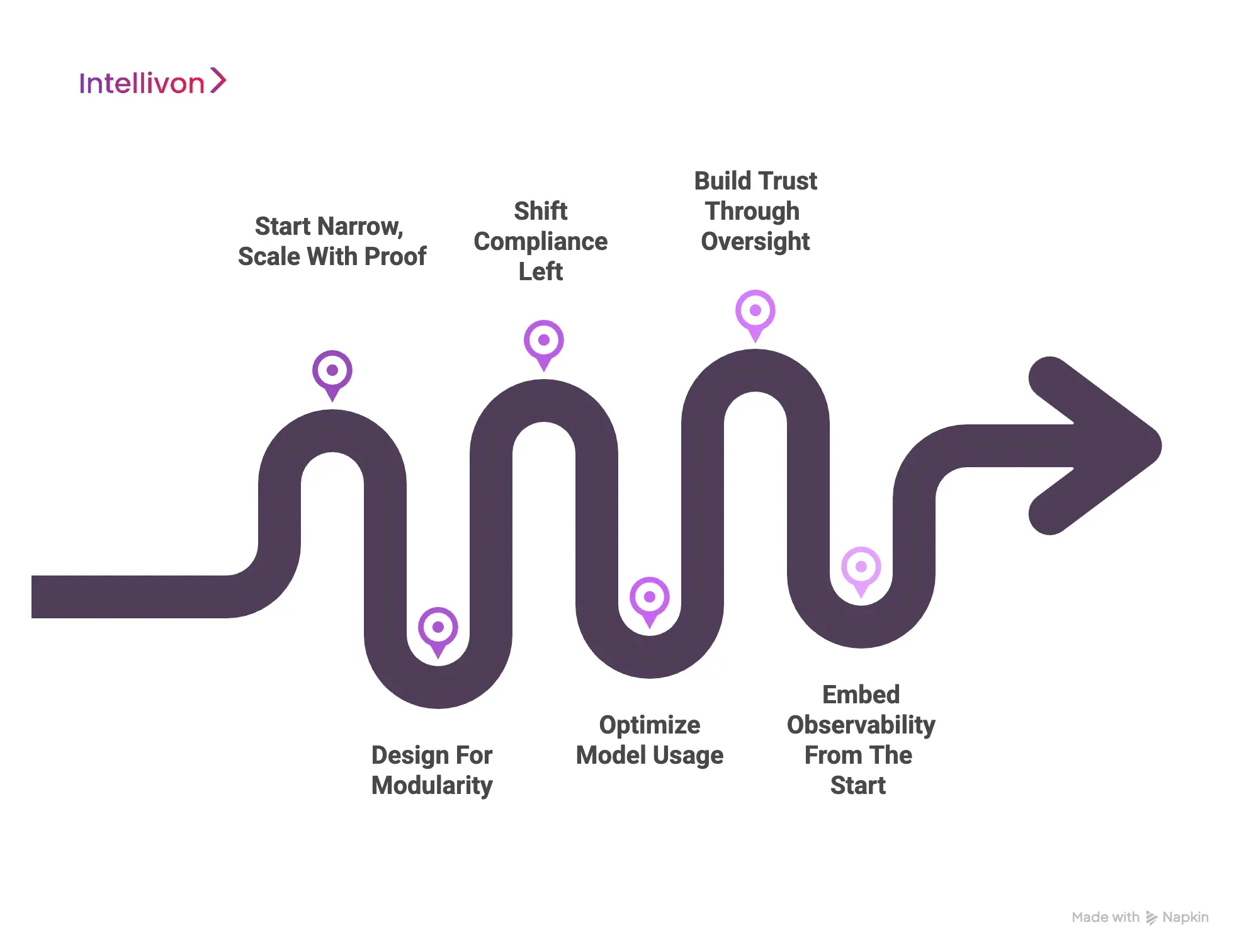
1. Start Narrow, Scale with Proof
Enterprises often try to deploy copilots across too many workflows too quickly. The result is diluted ROI and uneven adoption. Instead, start with one or two high-value workflows that solve visible pain points, for example, compliance reporting or invoice reconciliation.
Prove measurable ROI there, build internal success stories, and use that momentum to expand systematically across other functions.
2. Design for Modularity
Monolithic copilots are brittle. Every workflow requires customization, and scaling becomes a costly rebuild. A modular, skill-based architecture solves this problem.
By defining enterprise actions, like “draft a contract clause” or “generate a policy document”, as reusable skills, copilots can extend rapidly across business units. Modularity ensures that adding one new workflow strengthens the entire system, not fragments it.
3. Shift Compliance Left
Compliance added late in the process always leads to delays, rework, and higher costs. Copilots in regulated industries must embed compliance from the start. This means designing with encryption, role-based access controls, jurisdiction-aware data handling, and full audit trails baked in.
By shifting compliance left, copilots are not just safe to deploy, because they become regulator-ready infrastructure that accelerates enterprise approvals.
4. Optimize Model Usage
Running every task through a large foundation model may seem simple, but it quickly becomes unsustainable. Costs surge, latency increases, and accuracy suffers when models hallucinate.
A smarter approach is model routing: use lightweight LLMs for common tasks, retrieval pipelines for fact-grounding, and larger models only when complexity demands it. Combined with caching strategies, this balance keeps costs predictable without compromising outcomes.
5. Build Trust Through Oversight
The success of copilots depends on human adoption, and trust is the currency that drives it. Employees are more likely to embrace copilots when they know sensitive tasks, like contract approvals or regulatory filings, include human checkpoints.
By positioning human-in-the-loop oversight as a governance safeguard rather than a patch for errors, copilots gain credibility as partners that extend human capacity rather than replace it.
6. Embed Observability from the Start
Scaling copilots without monitoring is like flying blind. Leaders need continuous visibility into metrics like accuracy, latency, cost per task, adoption rates, and override frequency.
Embedding observability from day one means copilots can be treated as production-grade infrastructure, not experiments. This not only builds trust with executives but ensures issues are caught and corrected early, before scaling multiplies their impact.
When enterprises follow these best practices, copilots transition smoothly from proof-of-concept to enterprise-wide adoption. At scale, they become trusted infrastructure, which is secure, compliant, cost-efficient, and embedded into the daily fabric of how work gets done.
Conclusion
Enterprise AI copilots are becoming core infrastructure for organizations that want to scale productivity, compliance, and decision-making. By automating repetitive processes, copilots free employees to focus on high-value strategy. By embedding governance and observability, they make innovation safe in regulated industries. And by scaling across functions, they deliver a measurable ROI that compounds with every new workflow.
The enterprises that succeed will be those that treat copilots not as side projects, but as platforms that reshape how work gets done. That requires not just technology, but a partner who understands business priorities, regulatory landscapes, and global scale.
Build Your Enterprise AI Copilot with Intellivon
At Intellivon, we design enterprise-grade AI copilots that are secure, compliant, and tailored to the way global organizations operate. Our platforms are engineered for measurable ROI, helping enterprises streamline workflows, enforce governance, and scale innovation without disruption.
Why Partner with Intellivon?
- Tailored Solutions: Every copilot is aligned with your enterprise’s unique workflows, systems, and compliance obligations.
- Compliance-First Design: Built to meet GDPR, HIPAA, SOX, and global audit standards from day one.
- Proven Enterprise Expertise: 11+ years of experience and 500+ deployments delivering tangible value across industries.
- Scalable Architecture: Cloud-native, API-driven, and integration-ready with ERP, CRM, EHR, and custom enterprise systems.
Book a discovery call with Intellivon today to see how we can build copilots that not only automate tasks but also drive long-term enterprise growth.
FAQs
Q1. What makes enterprise AI copilots different from chatbots?
A1. Chatbots are designed to answer predefined questions, while enterprise AI copilots execute outcomes across workflows. Copilots interpret intent, plan multi-step tasks, and act within ERP, CRM, or compliance systems. They combine reasoning, execution, and governance, making them more than conversational interfaces.
Q2. How much does it cost to build enterprise AI copilots?
A2. The cost of developing enterprise AI copilots typically ranges from $50,000 to $150,000, depending on integration depth, scope, and compliance requirements. Ongoing maintenance adds 15–20% annually. Costs are influenced by model usage, data preparation, and the number of workflows targeted.
Q3. What industries benefit most from enterprise AI copilots?
A3. Industries with complex, repetitive, or compliance-heavy workflows benefit most from enterprise AI copilots. These include financial services, healthcare, legal, insurance, retail, supply chain, and energy. In each case, copilots reduce manual effort while ensuring accuracy, compliance, and measurable ROI.
Q4. How do enterprise AI copilots ensure compliance and security?
A4. Enterprise AI copilots embed governance directly into their architecture. They use encryption, access controls, audit trails, and explainability features to meet standards like GDPR, HIPAA, and SOX. This compliance-first approach ensures copilots can be scaled in regulated industries with confidence.
Q5. Can enterprise AI copilots integrate with legacy systems?
A5. Yes. Enterprise AI copilots are designed to connect with legacy ERP, CRM, HR, and supply chain systems through governed data fabrics and APIs. This allows enterprises to modernize workflows without replacing existing infrastructure, ensuring smoother adoption and lower transition risk.

